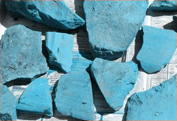
Once again our trip to Angers turned out to be great success with many interesting
places visited, but the highlight must surely be the trip to the Troglodytes caves of
Anjou. Centred on the town of Doué la Fontaine on the south side of the River Loire, they
cover a vast area and all were excavated by hand in the making of sarcophagi. Stone
extraction has been carried out here for centuries particularly in the early medieval
period. Recent evidence suggesting that some may go back as far as the 5th and 6th century
AD. The quarrying has resulted in huge caverns, some as big as cathedrals. They were
created because open quarrying was unaccepted to the local farmers who were unwilling to
give up their precious farmland. The stone coffins were exported all over France, but
demand fell when the church insisted that the souls of the dead did not permeate into the
stone, but went up to heaven instead. When the work ceased the people in the area decided
that the caves would make ideal homes so much of the population disappeared underground.
Society members were expertly guided through the caves by M Michel Cousins, who is not
only credited with the discovery of many of the earliest caves, but has also written a
highly acclaimed book on the subject (free copies of which were gratefully received by
society members). In the evening we enjoyed a very unusual meal with M Cousin and M
Broduer in a restaurant built inside one of the caves.
Chenehutte

Whilst most of our party were touring underground, some were above ground working on a
suspected Roman town. As mentioned in our previous newsletter M Boisbouvier had invited us
to demonstrate our resistivity meter on his site at Chenehutte, on the banks of the Loire.
In just a couple of hours we covered a 25m x 45m area in the centre of the site, just at
the point where he suspected two major roads intersected.
 As you cansee the results are quite spectacular.
Not only have we picked up the roads, but we also found the edge of the suspected forum. M
Boisbouvier is very excited by the image, as this is positive evidence for the layout of
the town. The only other evidence he has comes from aerial photos of crop-marks. M
Boisbouvier is now able to confirm many of his predictions, one of which is the
depression, centre left, which he is suggesting may be a fountain feature in the forum.
Another feature is the diagonal ditch running just above the depression. Our survey has
also captured the edge of a prominent building (top left), which again appears on his
photo. M Boisbouvier is keen for us to return some day to finish the whole field but he
may have to wait a year or two. As you cansee the results are quite spectacular.
Not only have we picked up the roads, but we also found the edge of the suspected forum. M
Boisbouvier is very excited by the image, as this is positive evidence for the layout of
the town. The only other evidence he has comes from aerial photos of crop-marks. M
Boisbouvier is now able to confirm many of his predictions, one of which is the
depression, centre left, which he is suggesting may be a fountain feature in the forum.
Another feature is the diagonal ditch running just above the depression. Our survey has
also captured the edge of a prominent building (top left), which again appears on his
photo. M Boisbouvier is keen for us to return some day to finish the whole field but he
may have to wait a year or two.
Tapis de Jean Lurçat
On the Friday when we arrived in Angers we were invited on a guided tour of this huge
tapestry which was inspired by the famous Apocalypse Tapestry in the castle. It was
started in 1957 and was still being worked on when M Lurçat died in 1966. Carrying on a
tradition of tapestry-making going back to the 15th century, M Lurçat has created a
spectacular modern work of art. I must admit though, my inspiration leant more towards the
building in which it is housed. Dating from the 12th century this former hospital,
dedicated to Saint Jean, is so big inside it could easily be mistaken for a large church
or abbey. In the grounds outside, cloisters add to this impression.
Falaise
On the way home on Sunday, our stop this year was at Falaise where William the
Conqueror’s castle provided further inspiration. Once again Adrian Morris has been
tasked with putting together a full presentation of our trip, which will be given at the
AGM in February.
Next Meeting
Wednesday 1st October at the BP Centre (Scout HQ) in Greenough Street, at 7.30 pm as
usual. Once again we are experiencing problems with our speaker. This month we were to
have had Brian Marshal, but he has been forced to postpone for health reasons. Instead we
have been able to secure Peter McCrones from the Lancashire
Archaeological Service who will be giving us a talk on ‘Recent Archaeological
Discoveries in Lancashire’.
Hope to see you there. B.A.
|



